(完整版)中国文化概况chapter 12
- 格式:ppt
- 大小:17.54 MB
- 文档页数:79
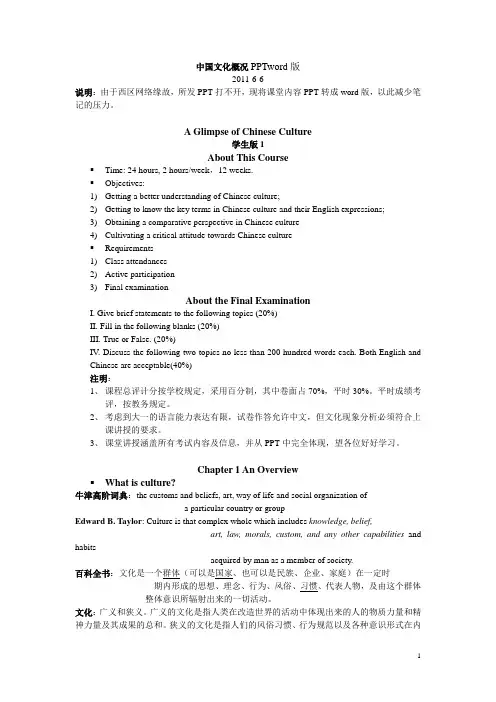
中国文化概况PPTword版2011-6-6说明:由于西区网络缘故,所发PPT打不开,现将课堂内容PPT转成word版,以此减少笔记的压力。
A Glimpse of Chinese Culture学生版1About This Course▪Time: 24 hours, 2 hours/week,12 weeks.▪Objectives:1)Getting a better understanding of Chinese culture;2)Getting to know the key terms in Chinese culture and their English expressions;3)Obtaining a comparative perspective in Chinese culture4)Cultivating a critical attitude towards Chinese culture▪Requirements1)Class attendances2)Active participation3)Final examinationAbout the Final ExaminationI. Give brief statements to the following topics (20%)II. Fill in the following blanks (20%)III. True or False. (20%)IV. Discuss the following two topics no less than 200 hundred words each. Both English and Chinese are acceptable(40%)注明:1、课程总评计分按学校规定,采用百分制,其中卷面占70%,平时30%。
平时成绩考评,按教务规定。
2、考虑到大一的语言能力表达有限,试卷作答允许中文,但文化现象分析必须符合上课讲授的要求。
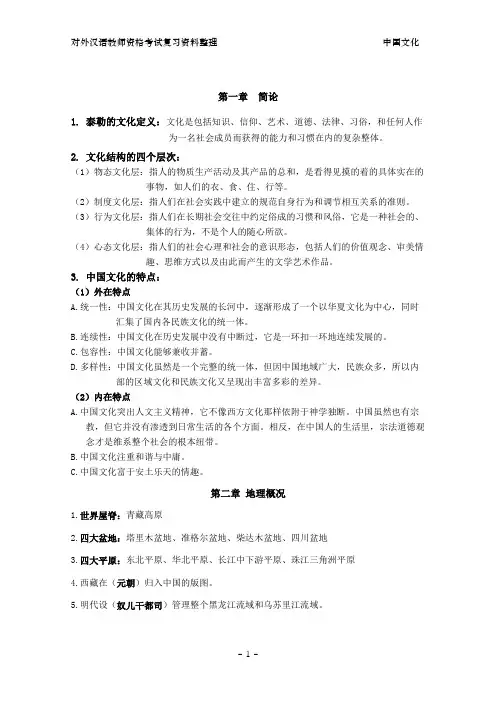
第一章简论1. 泰勒的文化定义:文化是包括知识、信仰、艺术、道德、法律、习俗,和任何人作为一名社会成员而获得的能力和习惯在内的复杂整体。
2. 文化结构的四个层次:(1)物态文化层:指人的物质生产活动及其产品的总和,是看得见摸的着的具体实在的事物,如人们的衣、食、住、行等。
(2)制度文化层:指人们在社会实践中建立的规范自身行为和调节相互关系的准则。
(3)行为文化层:指人们在长期社会交往中约定俗成的习惯和风俗,它是一种社会的、集体的行为,不是个人的随心所欲。
(4)心态文化层:指人们的社会心理和社会的意识形态,包括人们的价值观念、审美情趣、思维方式以及由此而产生的文学艺术作品。
3. 中国文化的特点:(1)外在特点A.统一性:中国文化在其历史发展的长河中,逐渐形成了一个以华夏文化为中心,同时汇集了国内各民族文化的统一体。
B.连续性:中国文化在历史发展中没有中断过,它是一环扣一环地连续发展的。
C.包容性:中国文化能够兼收并蓄。
D.多样性:中国文化虽然是一个完整的统一体,但因中国地域广大,民族众多,所以内部的区域文化和民族文化又呈现出丰富多彩的差异。
(2)内在特点A.中国文化突出人文主义精神,它不像西方文化那样依附于神学独断。
中国虽然也有宗教,但它并没有渗透到日常生活的各个方面。
相反,在中国人的生活里,宗法道德观念才是维系整个社会的根本纽带。
B.中国文化注重和谐与中庸。
C.中国文化富于安土乐天的情趣。
第二章地理概况1.世界屋脊:青藏高原2.四大盆地:塔里木盆地、准格尔盆地、柴达木盆地、四川盆地3.四大平原:东北平原、华北平原、长江中下游平原、珠江三角洲平原4.西藏在(元朝)归入中国的版图。
5.明代设(奴儿干都司)管理整个黑龙江流域和乌苏里江流域。
6.从秦汉到隋代实行(郡县制),从唐宋到辽金实行(道路制),元明清三代实行(行省制)。
7.汉武帝将国分为(十三刺史部(也称十三州)),属于监察性质,还不是行政区域,但却是中国行政区划史上设“州”的开始。
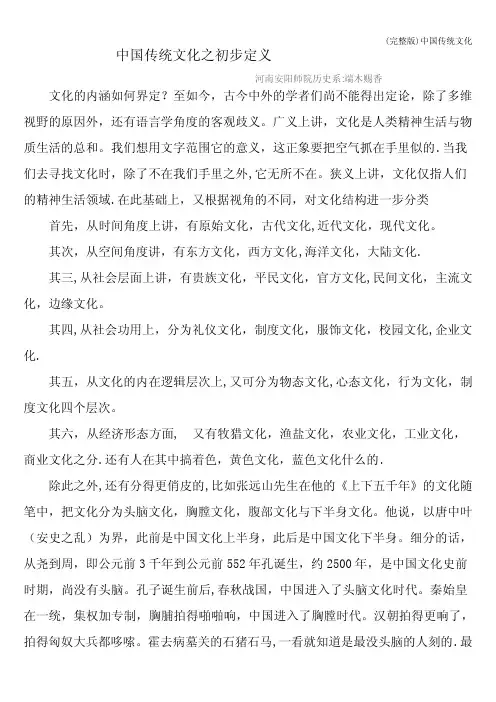
中国传统文化之初步定义河南安阳师院历史系:端木赐香文化的内涵如何界定?至如今,古今中外的学者们尚不能得出定论,除了多维视野的原因外,还有语言学角度的客观歧义。
广义上讲,文化是人类精神生活与物质生活的总和。
我们想用文字范围它的意义,这正象要把空气抓在手里似的.当我们去寻找文化时,除了不在我们手里之外,它无所不在。
狭义上讲,文化仅指人们的精神生活领域.在此基础上,又根据视角的不同,对文化结构进一步分类首先,从时间角度上讲,有原始文化,古代文化,近代文化,现代文化。
其次,从空间角度讲,有东方文化,西方文化,海洋文化,大陆文化.其三,从社会层面上讲,有贵族文化,平民文化,官方文化,民间文化,主流文化,边缘文化。
其四,从社会功用上,分为礼仪文化,制度文化,服饰文化,校园文化,企业文化.其五,从文化的内在逻辑层次上,又可分为物态文化,心态文化,行为文化,制度文化四个层次。
其六,从经济形态方面, 又有牧猎文化,渔盐文化,农业文化,工业文化,商业文化之分.还有人在其中搞着色,黄色文化,蓝色文化什么的.除此之外,还有分得更俏皮的,比如张远山先生在他的《上下五千年》的文化随笔中,把文化分为头脑文化,胸膛文化,腹部文化与下半身文化。
他说,以唐中叶(安史之乱)为界,此前是中国文化上半身,此后是中国文化下半身。
细分的话,从尧到周,即公元前3千年到公元前552年孔诞生,约2500年,是中国文化史前时期,尚没有头脑。
孔子诞生前后,春秋战国,中国进入了头脑文化时代。
秦始皇在一统,集权加专制,胸脯拍得啪啪响,中国进入了胸膛时代。
汉朝拍得更响了,拍得匈奴大兵都哆嗦。
霍去病墓关的石猪石马,一看就知道是最没头脑的人刻的.最有头脑的司马迁,却被最没头脑的武帝阉了下半身。
也是这个没头脑的汉武帝,宣布独尊儒术,导致中国两千年的知识分子大都成了无脑人。
总之,张先生这么分,分得很俏皮,之所以给大家罗嗦这么多,无非是想给大家一点启示,同学们如果有兴趣,不妨独创个分法来.【中国传统文化之关键词语】★传统纵览★:仁、义、礼、智、信、忠、孝、悌、节、恕、勇、让;琴棋书画、三教九流、三百六十行、四大发明、民间禁忌、精忠报国、竹、民谣、黄土、长江、黄河、红、月亮.。
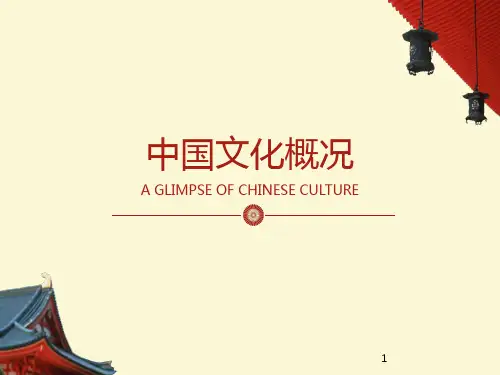
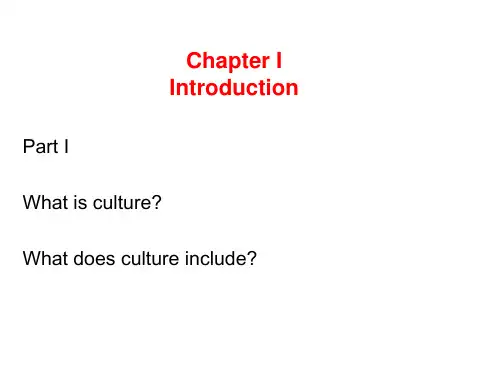
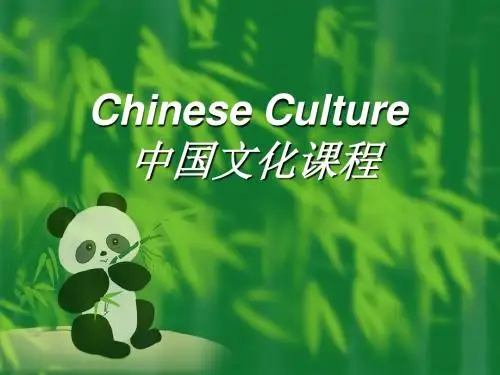
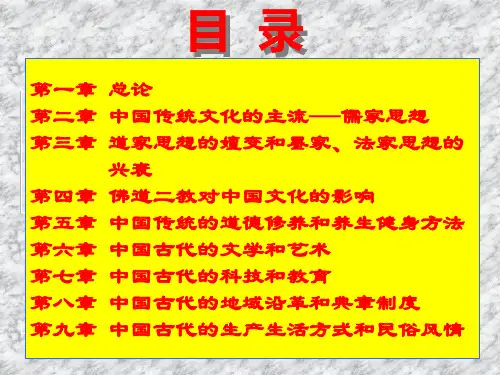
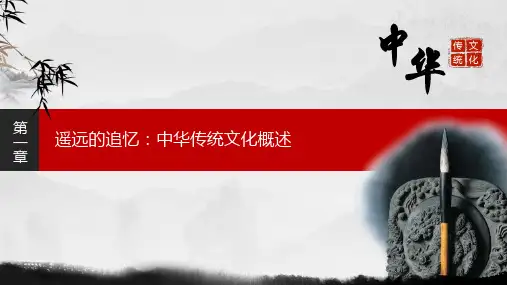

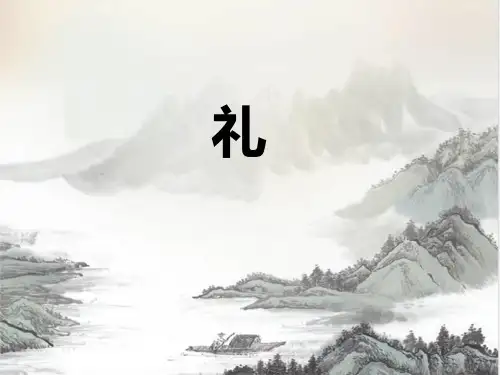
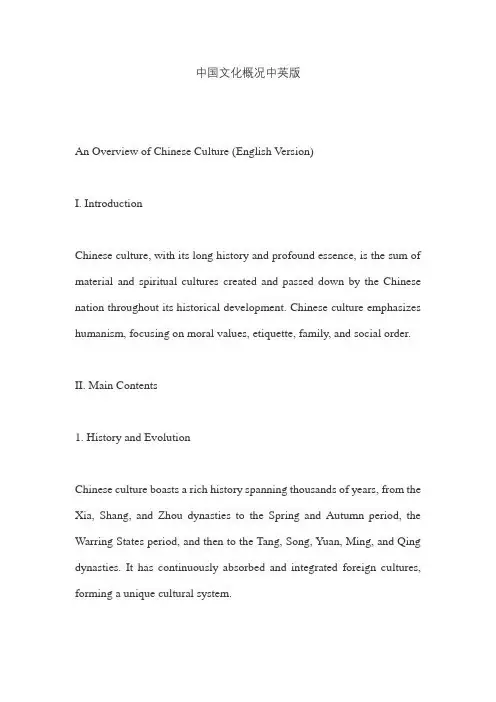
中国文化概况中英版An Overview of Chinese Culture (English Version)I. IntroductionChinese culture, with its long history and profound essence, is the sum of material and spiritual cultures created and passed down by the Chinese nation throughout its historical development. Chinese culture emphasizes humanism, focusing on moral values, etiquette, family, and social order.II. Main Contents1. History and EvolutionChinese culture boasts a rich history spanning thousands of years, from the Xia, Shang, and Zhou dynasties to the Spring and Autumn period, the Warring States period, and then to the Tang, Song, Yuan, Ming, and Qing dynasties. It has continuously absorbed and integrated foreign cultures, forming a unique cultural system.2. Traditional ValuesConfucianism is one of the cornerstones of Chinese culture, emphasizing virtues such as benevolence, filial piety, loyalty, and etiquette, which have profoundly influenced the behavior and values of the Chinese people. Taoism emphasizes the harmony between man and nature, advocating a natural and non-interventionist approach. Buddhism, on the other hand, emphasizes compassion and self-sacrifice, having a significant impact on Chinese religion and philosophy.3. Cultural Characteristics- Festival Culture: China has many traditional festivals, such as the Spring Festival, Mid-Autumn Festival, and Dragon Boat Festival, each with unique celebration methods and cultural connotations.- Clothing Culture: Traditional Chinese clothing, such as Hanfu and Tangzhuang, reflects the unique aesthetic concepts and cultural characteristics of the Chinese nation.- Architectural Culture: Traditional Chinese architecture, including palaces, temples, and gardens, is renowned for its distinctive styles and exquisite craftsmanship.- Cuisine Culture: Chinese cuisine, known for its rich flavors and exquisiteculinary techniques, is an important representation of China's cultural charm.4. Influence on the WorldThe values and ideological systems of Chinese culture have had a profound impact on the world, especially Confucianism, which has influenced Asia and beyond. Traditional Chinese arts and forms of expression, such as calligraphy, painting, and Peking Opera, are also deeply loved and admired by people around the world.III. ConclusionChinese culture is a treasure of the Chinese nation, embodying unique charm and value. Through learning and understanding Chinese culture, we can gain a deeper understanding of the history, traditions, and spiritual outlook of the Chinese people, further enhancing our sense of national pride and self-confidence. At the same time, Chinese culture has also made significant contributions to the diversity and development of world culture.中国文化概况中英版一、引言中国文化,源远流长,博大精深,是中华民族在长期历史发展过程中所创造并传承下来的物质文化和精神文化的总和。
Chapter 1 A General Introduction to Chinese CultureWords and Expressions:the descendants of Yan and Huang 炎黄子孙porcelain 瓷器The appellation of ChinaChinese history began with two legendary figures—Emperor Huang and Emperor Yan, who, together with their tribes, inhabited the drainage area along the middle reaches(中游)of the Yellow River. By the time of Xia Dynasty, after centuries of living side by side, these two tribes had gradually merged into(合并,融合)one. Consequently, the Chinese people usually call themselves “the descendants of Yan and Huang”.People at that time believed that the land they lived on was the center of the world, and called their state the "Middle Kingdom"(中国), thus giving China its country name.China is the appellation of our country given by foreigners. The porcelain china is the transliteration of the place name Changnan(昌南), which was the old name for Jingdezhen(景德镇). The porcelain made in Changnan was smooth and bright, and earned another name of artificial jade. It became famous both home and abroad and was exported to Europe in large quantities.In Europe, people regarded Changnan porcelain as something precious and delicate and would take pride in possessing one. As time passed, people in Europe forgot the meaning of Changnan and switched the original meaning of porcelain of the word “china” to the place of its origin.Chapter 2 Chinese Philosophy and ReligionPart 1 Chinese Thoughts and PhilosophyWords and Expressions:Confucianism 儒家Taoism 道家The Analects 《论语》benevolence 仁慈,善行ritual礼制,仪式,惯例filial piety 孝,孝心The Development of Ancient Chinese PhilosophyThe philosophy in Pre-Qin times (先秦子学)The orthodox philosophy during the Han Dynasty (两汉经学)Metaphysics during the Wei and Jin dynasties (魏晋玄学)The buddhist philosophy during the Sui and Tang dynasties (隋唐佛学)Neo-confucianism in Song and Ming dynasties (宋明理学)Application philosophy in the Ming and Qing dynasties (明清实学)The philosophy in Pre-Qin times (先秦子学)The philosophy in Pre-Qin times was marked by the emergence of various ancient philosophical views.The most influential schools were Confucianism (儒家), Taoism (道家), Mohism (墨家) and Legalism (法家)Confucianism is a school of thought represented by Confucius and Mencius. Confucianism has influenced the Chinese for thousands of years and is deeply rooted in Chinese culture. It is an integration of intellectual, political, and religious tradition with the focus on the individual morality and ethics in daily life and the proper exercise of political power.Who is Confucius?Family name: Kong; Given name: Qiu; courtesy name: ZhongniHe is a great thinker, an educator, a statesman, a philosopher, the founder of the Confucian school and Confucianism.The landmark of Confucianism is the Analects, which was written by his disciples after his death. The core of Confucius’s philosophy are the concepts ofRen (benevolence)Ren(仁): Confucius defines it as “Airen”(爱人),that is , to love others.The Chinese character “仁”(benevolence) consists of “a person (人)” on the left and“two(二)” on the right indicating the relationship between people.Li (ritual)Li (ritual-礼)refers to the rules of human conduct and moral norms such as politeness, courtesy, propriety, proper etiquette and good manners ranging from speech and behavior to the performance of rituals which are usually codified and treated as an all-embracing system of socialnorms.Xiao (filial piety)Xiao(孝)refers to the filial piety, which was regarded as one of the greatest of virtues in Chinese tradition, denoting the respect and obedience that the children should show to their parents. Zhong (loyalty)Zhong(loyalty-忠)is a great virtue, which emphasizes the obligations and duties to the superior, to friends, family, and spouse.2. TaoismFounded by Lao Zi and Zhuang Zi, the school advocates the doctrine that the Dao is the course, the principle, the substance, and the standard of all things, to which all of them must conform. Based on the work of Dao De Jing, Taoism promotes the belief that a person should live a simple life, not to strive for wealth, fame or power, which will only give one worries and trouble. The school favours the political principle of “achieving good government through non-action”(无为而治)3. MohismBase on the teaching of Mozi, the school cherishes universal love which states that if all the people in the world loved one another, there will be no hatred, calamities, and hostilities.In politics and ethics, Mohism proposes honoring virtuous people, opposing fatalism (宿命论) and aggressive wars, and upholding thriftiness(节俭).4. LegalismLegalism, begun by Hanfeizi, espouses (主张) laying down laws to unify the thought of people, promoting agriculture to achieve affluence (富裕), waging (进行) wars to gain strength and power, and establishing a system of bureaucracy (官僚制度).The orthodox philosophy during the Han Dynasty (两汉经学)In the Han Dynasty, Emperor Wudi instituted the campaign of “banning all schools of thought except Confucianism(罢黜百家,独尊儒术)”. He chose officials from th ose who were steeped in Confucianism only. Consequently, Confucianism became an orthodox school that served as the ideological foundation of the feudal rule throughout the dynasties in China.Traditional Chinese ethicsTraditional Chinese ethics includes both good and bad elements. Some reflect the high standard ofmoral pursuit of the Chinese people, while others seem less relevant in modern society. For example, the three obediences and four virtues (三从四德) and the three basic rules and five constant virtues (三纲五常) have long been abandoned by the Chinese people.The traditional ideal of a woman is that she is a dependant being whose behavior is governed by “three obediences” (to father before marriage, to husband after marriage, and to son after becoming a widow: 未嫁从父, 既嫁从夫, 夫死从子) and four “virtues” (morality, pro per speech, modest manner, and diligence: 品德、言语、仪态、女工).These were the social norms prescribed by feudal morality.The three basic rules: a king should rule over his subjects; a father, his son; a husband, his wife (君为臣纲、父为子纲、夫为妻纲).The five constant virtues: benevolence, righteousness, propriety, wisdom, and fidelity (仁、义、礼、智、信).Part 2 Religions and BeliefsWords and Expressions:Heaven worship 祭天Ancestor worship 祭祖Confucianism 儒教The Confucian Temple 孔庙Taoism 道教The Five Elements 五行Buddhism 佛教Buddha 佛像,佛祖,佛陀nirvana涅盘The heaven worship was the bureaucratic(官僚的) belief system adopted by most dynasties of China until the overthrow(推翻) of the Qing Dynasty.Heaven was believed to manifest itself through the powers of the weather and natural disasters. Heaven was seen as a judge of humans.The emperors are Sons of Heaven(天子), and their power are authorized by heaven. Such beliefs actually consolidated(巩固) the authority of the Emperor.Ancestor worshipChinese worship of ancestors dates back to the prehistory. Chinese culture, Confucianism, and Chinese Buddhism all value filial piety as a top virtue, and the act is a continued display of piety and respect towards departed ancestors.儒教Confucianism is not a real religion, it is just an ethical(伦理道德的) and philosophical system, which developed from?Confucius’ thoughts and later was treated as a kind of belief to educate common people(教化大众).The Taoist ReligionA General Introduction of TaoismTaoism is the indigenous (土生土长的) religion in China.The Taoist religion evolved out of witchcraft (巫术), necromancy(方术) and self-cultivation techniques. Its highest belief is called “Dao”, its bible is called “Dao De Jing”. It had great impact on the thinking of the Chinese people, as well as on the political, economic and cultural life of the country.BeliefsYin-yang TheoryYin-yang are opposing, Yin-yang are mutually rooted, Yin-yang mutually transform, Yin-yang mutually wax and waneThe Five Elements/Wuxing“五行”The relationship between the five elements:The Generating CycleWood feeds Fire; Fire creates Earth; Earth bears Metal; Metal carries Water; Water nourishes Wood.The Overcoming CycleWood parts Earth; Earth absorbs Water; Water quenches Fire; Fire melts Metal; Metal chops Wood.BuddhismBuddhism is the most important religion in China. It is generally believed that it was spread to China in 67 AD during the Han Dynasty (206 BC-220) from Hotan(和田)in Xinjiang to Central China. During its development in China, it has a profound (深远的)influence on traditionalChinese culture and thoughts, and has become one of the most important religions in China at that time.Its Deity is Sakyamuni(释迦牟尼);Its doctrine is based on transmigration(轮回).What is the fundamental cause of all suffering?Desire!What did the Buddha teach?The doctrine of Four Noble Truths (四谛)⏹life is suffering,⏹the cause of suffering is desire,⏹the answer is to quench (抑制) desire,⏹the way to this end is to follow the Eight-Fold Path (八正道).What do Buddhists believe?Nirvana is a peaceful, detached state of mind.Achieving Nirvana means escape from the cycle of rebirth.Buddhism in China has developed into three sections, namely the Han, Tibetan and Southern Buddhism.Chapter 3 Chinese Characters, Calligraphy and PaintingWords and Expressions:Chinese Characters 汉字calligraphy书法calligrapher书法家Oracle bone script甲骨文The regular Script 楷书文房四宝brush 毛笔ink stick 墨ink stone 砚台records by tying knots (结绳说)Eight Diagrams (八卦说)Jie created the characters(仓颉造字说)The evolution of Chinese characters font(汉字的字体演变)Oracle bone scriptIt refers to incised(雕刻的) ancient Chinese characters found on oracle bones, which are animal bones or turtle shells used in divination(预言) in ancient China.Bronze ware script金文It refers to characters found engraved on bronze vessels, utensils, weapons etc.The Seal Characters (篆书)Soft lines of strokes and upright rectangular shape keep the seal form characters more close to pictography (象形文字). Each of the characters has a balanced and symmetrical (对称的) pattern. The Official Script(隶书)It was the turning point in the evolution of Chinese scripts and is the foundation of the later script forms. It turned the remaining curved and round strokes of the seal form into linear (直线的) and flat square (扁方形) shapes.The regular Script (楷书)It is still today’s standard writing. It is square in form, and non-cursive in strokes.The running Script (行书)The running form is somewhere between the regular and the cursive forms allowing simpler and faster writing.The Cursive/Grass Character(草书)This style of calligraphy is smooth and lively with strokes flowing and characters linking characters are often joined, with the last stroke of one merging into the initial stroke of the next. It is executed freely and rapidly so that parts of the characters appear exaggerated (夸张的). CalligraphyPlaying musical instruments, playing chess, calligraphy and painting were considered as the four essential skills for a learned scholar.The Chinese saying “The handwriting reveals the person” (字如其人), is directly related to calligraphy.文房四宝brush毛笔ink stick墨paper 纸ink stone砚Famous Chinese Calligraphers in History—the sage of Chinese calligraphyZhang Xu (张旭)——the “sage of the cursive hand””草圣”Yan Zhenqing——the four greatest masters of Regular script.Liu Gongquan——a master of Regular Script and Running-cursive(行草)PaintingPaintingChinese Traditional Painting refers to ink - wash painting (水墨画) .Traditional Chinese paintings are not “purely” paintings. T hey combine fine art, poetry, calligraphy, and seal engraving to achieve an artistic unison (一致). Human figures, landscapes, flowers, birds, and pavilions are the most important themes of traditional Chinese painting.The classification of Chinese paintingAccording to subject matterFigure paintingLandscape paintingBird-and-flower paintingAccording to the techniqueThe xie yi schoolThe gong bi schoolChapter 4 LiteratureWords and ExpressionsCelestial Poet (诗仙)Saint Poet (诗圣)Romance of the Three Kingdoms 《三国演义》Water Margin《水浒传》Journey to the West《西游记》Dream of the Red Mansions《红楼梦》The Tang PoemThe Tang Dynasty saw the continued development of Chinese poetry. The Complete Anthology of Tang Poems (《全唐诗》), edited in the early Qing Dynasty, is the biggest-ever collection of Chinese poetry. It contains 48,977 poems by 2,208 poets who wrote in different styles.The development of poetry in the Tang Dynasty can be classified into four stages, namely EarlyTang, High Tang, Mid Tang, and Late Tang (初唐,盛唐,中唐,晚唐)Early TangThe Four Literary Eminences(初唐四杰)Wang Bo, Yang Jiong, Luo Binwang, and Lu ZhaolinHigh TangA whole generation of literary giants appeared during the High Tang period when society enjoyed prosperity and stability. Li Bai and Du Fu are regarded as the twin master poets of the Tang Dynasty.Li Bai,the “Celestial Poet (诗仙)”, has long been regarded the greatest romantic poet in Chinese literature. In his poems, imagination, exaggeration, diction and sonorous rhythms are blended effortlessly.Du Fu, the “Saint Poet (诗圣)”, has been considered as the greatest realistic poet in Chinese literature. A mirror of the times, his poems faithfully and profoundly reflect the social realities of Tang Dynasty in decline, like a poetic historical account. Because he reached perfection in developing a depressing literary style, his works have been considered as the classics of realism. The other poets in this period can be grouped into two categories: frontier poets (边塞诗人)represented by Gao Shi and Cen Shen, and pastoral poets (田园诗人)represented by Meng Haoran and Wang Wei.Mid-TangThe outstanding poet Bai Juyi succeeded Du Fu with poems reflecting the reality of society.Late TangWith the deterioration of the government in the late Tang Dynasty, the poems reflected, more and more, the hopeless and helpless feelings of the people. Poets turned to the theme of nostalgia (怀旧) for the former splendor (辉煌)of old times. The most talented of these were Li Shangyin and Du Mu, who were often called “Young Li Bai and Du Fu”.Fiction in the Ming and Qing DynastyIn the Song Dynasty, huaben (话本), the earliest novels written in colloquial language started to appear. By the Ming and Qing dynasties, novels grew rapidly as a lively and free literary form. The language of the novels was simple, easy to understand, and welcomed by the public.Four famous Chinese classical novelsRomance of the Three Kingdoms 《三国演义》Water Margin《水浒传》Journey to the West《西游记》Dream of the Red Mansions《红楼梦》On 11 October 2012, the announced that Mo Yan had received the Nobel Prize in Literature for his work . Aged 57 at the time of the announcement, he was the 109th recipient of the award and the first ever resident of mainland China to receive it .Mo Yan has written 11 novels, and several novellas and short story collections.《红高粱家族》, 《天堂蒜薹之歌》The Garlic Ballads, 《十三步》Thirteen Step,《食草家族》The Herbivorous Family, 《丰乳肥臀》Big Breasts and Wide Hips, 《酒国》The Republic of Wine: A Novel,《红树林》Red Forest, 《檀香刑》Sandalwood Death, 《生死疲劳》Life and Death Are Wearing Me Out, 《四十一炮》Pow!, 《蛙》FrogChapter 5 EducationWords and ExpressionsPrivate Schools私塾Official Schools官学the Four Books and the Five Classics四书五经Imperial Examination 科举Nine-year Compulsory Education 九年制义务教育V ocational Education 职业教育College Entrance Examination 高考Bachelor’s degree学士学位Master’s degree 硕士学位Doctor’s degree 博士学位Confucius Institute孔子学院Private SchoolsA private school refers to a school set up by a family, clan, or teacher that generally had just one teacher who gave individual tuition, and that had no set textbooks and no specified time span of study.In the Spring and Autumn Period, private schools prevailed and many scholars of different schools of thought spread their teaching in this way. Among them, the private school run by Confuciuswas the largest and most influential.Confucius’ private school:3000ciples(弟子); 72 virtuous and talented studentsConfucius’ educational ideas:“Education should be for all, irrespective of their social status.”(有教无类)“Six arts”: ritual, music, archery, chariot-riding, writing, and arithmetic.(六艺:礼、乐、射、御、书、数)Official SchoolsOfficial schools began during the Western Zhou Dynasty, and were sponsored by the official constitution called Xiangxue .Only children of nobles were admitted.The teaching materials were centered on the Four Books and the Five Classics(四书五经). Imperial Examination System (科举)Imperial Examination System in China began in the Sui Dynasty and lasted more than 1,300 years until the last examination was held during the Qing Dynasty.It was conducted at two levels: xiangshi(乡试) and huishi(会试)During the Ming and Qing Dynasty, the examination was designed to select jinshi(进士). It featured writing ,which involved the writing of an Eight-part Essay(八股文).After the Opium War in 1840 with the spread of the Western ideology and technology in China , it was under attack by people. It was abolished in 1905.Nine-year Compulsory EducationThe law of compulsory education came into effect on July 1, 1986, requiring each child to have nine years of formal education.China’s Nine-year Compulsory Education is composed of two parts: six-years in primary school and three-years in junior high school.In 1989, China launched two ambitious projects: Project Hope (希望工程) and the Spring Bud Project (春蕾计划) These two projects have helped children, especially girls, in poor areas to attend schools.The National College Entrance Examination is an academic examination held annually in China aimed to select high-school graduates for college admissions.Higher EducationMore than two thousand universities, colleges, and institutes in China offer four or five-year programs. Students who have earned Bachelor of Arts or Science degrees may apply for Master of Arts or Science programs and then three-year Doctor of Philosophy .) programs.Confucius InstituteConfucius Institute is not a general sense of the university, but the promotion and dissemination (传播)of Chinese culture and Chinese language education.Chapter 6 Dress and Adornment CultureWords and Expressionsattire/ costume/trappings 服装、服饰The Silk Road 丝绸之路The Maritime Silk Road海上丝绸之路embroidery/im‘br?id?ri /刺绣;刺绣品Li Brocade 黎锦The Intangible Cultural Heritage 非物质文化遗产China has many ethnic groups with a long history. For thousands of years, generations of clothing designers have devoted themselves to building the Kingdom of Clothes, making the garments that cover the human body into an important component of Chinese culture.Cheong-sam came from Qizhuang of manchu women’s costume. The cheongsam is easy and comfortable to wear, snugly fitting the female Chinese figure. Its neckline is high, collar closed, and its sleeves may be short, medium or full length, depending on the sea son or the wearer’s taste. The dress is buttoned on the right side, with a loose bodice, a fitted waist, and side-slits to the hem, all of which combine to set off the beauty of the female’s figure.Chinese tunic suit (Zhongshan suit /Mao suit)The modern Chinese tunic suit is a style of male attire known in China as the Zhongshan suit, and known in the West as the Mao suit (after Mao Zedong). Sun Zhongshan introduced the style shortly after the founding of the Republic of China as a form of national dress although with a distinctly political and later governmental implication.A tang costumes (literally: "Chinese suit" ) is a Chinese jacket that originated at the end of theQing Dynasty. The tangzhuang evolved from the magua (Chinese: 马褂), which the Han Chinese were forced to wear it during the Qing Dynasty. In modern times it has been adopted by common people. They are often worn by men, although women wear them as well.In Chinese communities, the Zhongshan suit, the western suit, and the Tang suit are the main forms of formal dress for men on many occasions.The Silk RoadThe Silk Road refers to the ancient trade route connecting Asia Continent and European Continent, usually it can be classified into Northern Silk Road on the land, and the Maritime Silk Road. Embroidery (刺绣)Embroidery is a traditional Chinese handicraft featuring flowers, birds and scenery on silk or other cloth in colored silk threads. Chinese embroidery dates back over 3,000 years. It has distinct regional and ethnic characteristics.Embroidery in China includes:Shu Embroidery (蜀绣) from Sichuan,Su Embroidery (苏绣) from SuzhouSu embroidery enjoys a good reputation of the first of the Top-four embroidery in China.Xiang Embroidery (湘绣) from HunanYue Embroidery (粤绣) from Guangdong.Acclaimed as a "living fossil" of Chinese textiles, the Li-style brocade was chosen in the first batch of items for the Intangible Cultural Heritage list released by UNESCO in 2009. The Li brocade has been part of China's national cultural heritage, but as few people nowadays have the skills necessary to weave the special brocades, the practice is in danger of becoming extinct.Chapter 7 Part 1Food CultureWords and Expressionsfoodie 吃货culinary厨房的,烹饪的;烹调用的cuisine烹饪,烹调法;菜肴main food主食,主粮(staple food )aroma芳香,香味seasonings调味品、调料A general introduction of Chinese foodChinese cuisine(菜肴)is widely seen as representing one of the richest and most diverseculinary(烹饪的) cuisines and heritages in the world.A meal in Chinese culture is typically seen as consisting of two or more general components: Zhushi (main food)---typically rice, noodles, or mantou (steamed bun), and accompanying dishes of vegetables, meat, fish, or other items, known as cai (dish) in the Chinese language. This cultural conceptualization is in some ways in contrast to cuisines of Northern Europe and the USA, where meat or animal protein(蛋白质) is often considered the main food(主食).Chinese cuisine is a complete presence of color, aroma(芳香,香味) and taste. (色香味俱全)In China, we have eight branches of cuisine.Shandong Cuisine山东菜系(鲁菜)Guangdong Cuisine广东菜系(粤菜)Sichuan Cuisine四川菜系(川菜)Hunan Cuisine湖南菜系(湘菜)Jiangsu Cuisine淮扬菜系(苏菜)Zhejiang Cuisine浙江菜系(浙菜)Fujian Cuisine福建菜系(闽菜)Anhui Cuisine安徽菜系(徽菜)Hainan CuisineHainan is noted for its "Four Best Known Dishes" -- Wenchang Chicken, Jiaji Duck, Dongshan Mutton东山羊and Hele Crab和乐蟹.Chapter 7 Part 2 Tea and Wine CultureA Brief Introduction to Tea CultureTea (茶) commonly denotes the drink made from steeping(浸泡)the processed leaves, buds(芽), or twigs of the tea bush (茶树) in water.On both casual and formal Chinese occasions, tea is consumed regularly. In addition to being a drink, Chinese tea is used in Traditional Chinese medicine and in Chinese cuisine.It is universally acknowledged that China is the original tea-growing area, as well as the first country to grow, produce and drink tea.At the end of the sixteenth century, the Dutch(荷兰人) brought word to Europe that there was a kind of magic leaf in the east, from which tasty drinks could be made, and this was the first time that Europeans heard of tea.In 1610, the East India Company(东印度公司) was the first to sell tea to Europe, after which the habit of drinking tea took root there. Britain is famous for its tea drinking.The Classifications of Chinese TeaGreen tea绿茶Black tea红茶Oolong tea乌龙茶Yellow tea黄茶White tea 白茶Scented tea花茶Compressed tea砖茶Unique customs of taking tea in different regions:GuangdongFujian Kongfu teaSichuan “Covered-bowl tea”Tibetan Buttered tea(酥油茶)Inner Mongolia Milk teaHainan Laoba TeaHainan Laoba Tea“Laoba tea”(Laoba means father) is a spec ial scene in Haikou, a pot of tea with some snacks, people sit around an old table,for killing time and strengthening the relationship with theirs friends, it hasn’t the limitation of time or place. Most of places of traditional Laoba tea are barely furnished, the prices of food and tea there are cheap. The teahouse of Laoba tea is a little world of society, a mirror of the traditional life in Hainan.The Functions of Offering TeaTo show respectTo apologizeTo express thanks to the elders on one’s wedding dayTea EtiquetteServing a cup of tea is more than mere politeness.When offered tea, it is considered polite to at least take a sip.When you pour tea, the rule of “full cup for wine and half cup for tea”should be observed.Chinese Wine CultureThe Origin of Chinese WineChinese wine, as a special form of culture, has a history of more than five thousand years . Chinese wine making can be traced back as far as 4000 BC, to the early period of the Neolithic Yangshao Culture (新石器时代的仰韶文化). During its long development, Chinese wine has developed distinctive characteristics.Types of Chinese WineHuangjiu (yellow rice wine)Huangjiu is one of three dominated brewed wines (beer and grape wine) in the world. Huang Jiu predates all the other liquors, with a history of several thousand years. Among these liquors the Shaoxing Rice Wine is the most famous.Baijiu(white wine)Being made from sorghum, corn, barley or wheatFruit WineFermented alcoholic beverages made from a variety of base ingredients (other than grapes); May also have additional flavors taken from fruits, flowers, and herbs.Red WineA type of wine made from dark-coloured (black) grape varieties. The actual colour of the wine can range from intense violet, typical of young wines, through to brick red for mature wines and brown for older red wines.BeerToast etiquetteChinese Drinking Etiquette(礼仪)The Chinese people care more about the people we drink with.That is Chinese drinking etiquette reflects the respect of the drinkersThe host and guests have their own seat and order of toast(敬酒顺序)When toast,the host come first,and firstly,they should toast the most honored guest.The wine vessel must be full.The younger should toast the elder and drink all of the wine.(先干为敬)Western Drinking EtiquetteThe drinking etiquette of west show the respect of wine.To distinguish wine we need to watch its color, smell its fragrance, taste its taste(观其色、闻其香、品其味). They drink for enjoying, so sometimes they drink themselves. They do not encourage others to drink, neither do they consider letting other drunk is a way to show their etiquette.Chapter 4 Traditional Festivals and CustomsWords and ExpressionsLegal holiday/ official holiday 法定节假日Solar calendar阳历Lunar calendar 阴历/ Agricultural calendar 农历Spring Festival (春节)Lantern Festival (元宵节)Tomb-sweeping Festival/ Qing Ming Festival (清明节)Dragon Boat Festival(端午节)Mid-autumn Festival (中秋节)Double Ninth Festival (重阳节)Intangible Cultural Heritage非物质文化遗产Spring Festival (春节)China’s most important festival falls on the 1st day of the 1st lunar month each year. Family members gather just as they do for Christmas in the West.CustomsSpring CleaningWrite and paste couplets(对联) on doorsSet off fireworksReceive Gift MoneyGreet each otherLantern Festival (元宵节)The Lantern Festival, celebrated on the 15th day of the first lunar month, is closely related to the Spring Festival. It marks the end of the New Year celebrations, following which life returns to normal. The most prominent activity of the Lantern Festival is the grand display of beautiful lanterns.。